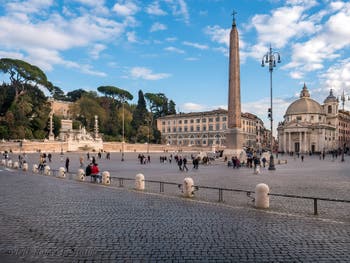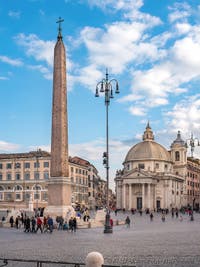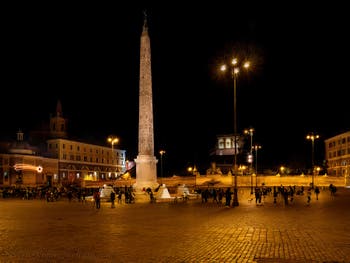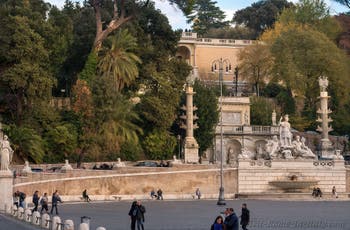Fountains Squares Bridges Trevi Fountain | St-Peter Square | Popolo |
Piazza del Popolo, Piazza del Popolo and its obelisk in Rome, Italy
Piazza Santa Maria del Popolo, the gateway to Rome

Piazza del Popolo and its obelisk The marble entrance to the square, the Porta Flaminia, was rebuilt at the end of the Renaissance.
Pilgrims and travellers coming from the North entered Rome through this door.
The reconstruction of the gate, entrusted to Gian Lorenzo Bernini by Pope Alexander VII Chigi, was decided to honour Christine of Sweden, officially “king” of Sweden.
To welcome her, the door was engraved with: “Felici Faustoque Ingressui” or “Happy and successful arrival.”
Martin Luther was lodged in Piazza del Popolo
Martin Luther entered Rome through this Flaminia gate and was lodged in the Augustinian friar’s Monastery in Piazza del Popolo for his stay in Rome.
Piazza Popolo obelisk A stay at the end of which, disgusted by the lust, venality and corruption of the leaders of the Church of the time, he launched the Reformation movement that led to the creation of Protestantism.
As he left the square, he supposedly shouted: “Farewell Rome, a city that every soul in search of a pious life must flee from! ”.
The Obelisk in Piazza del Popolo
An obelisk stands in the centre of Piazza del Popolo.It is one of the 14 obelisks that are located in Rome.
They say there are more obelisks in Rome than in any other city, including Cairo in Egypt!

Piazza Popolo obelisk In ancient Rome, most of them were installed in arenas and circuses.
They were then abandoned, and many ended up buried and often broken, probably demolished as pagan monuments by fanatic Christians.
The obelisks of Rome were restored to honour by the popes who surmounted them with the cross and consecrated them as instruments of exorcism, pointed at Satan!
The obelisk in Piazza del Popolo is 24 metres high.
It is 3,300 years old and was brought back to Rome by Emperor Augustus after his victory over Cleopatra and Mark Antony.It was erected at the “Circus Maximus”.

Piazza del Popolo and its obelisk It remained in pieces until the end of the 16th century when Pope Sixtus V installed it in the centre of People's Square.
Hieroglyphs in honour of Pharaohs Ramses II and Seti I
The hieroglyphs engraved there are in honour of the Pharaohs Ramses II and Seti I.At the base of the obelisk, you can read inscriptions from the time of Augustus, who dedicated the obelisk to the Sun, as well as those of Sixtus V, who, this time, dedicated it to the Holy Cross.
One of these inscriptions even gives a voice to the Christianized obelisk:

Piazza Popolo obelisk “I am happier here than before, in front of the temple of the woman who, in the time of Augustus, gave birth to the Sun of Justice from her virginal womb.”
Piazza del Popolo: A perfect fusion of different styles
The square is so harmonious that it is almost impossible to guess what you are presented with is the result of an accumulation of architectural elements of other types spread over three centuries.The side overlooking Corso and Via del Babuino, with its two twin Baroque-style churches, was built in the 16th century when the obelisk was added.
And the beautiful church of Santa Maria del Popolo, in the style of the early Roman Renaissance, blends perfectly into this setting.
The Roman architect Giuseppe Valadier

Piazza del Popolo in Rome, Italy This harmonious blend of such diverse styles and monuments goes to the Roman architect Giuseppe Valadier who gave the place its final shape and ambience in the 19th century, at the time of the occupation of Rome by Napoleonic armies.
Valadier is responsible for the fountains and statues surrounding the obelisk, as well as the low buildings and neoclassical balustrades that visually unite the entire square by highlighting the symmetry of all its architectural elements.
Valadier also knew how to link the square’s architectural elements and the green and wooded slope to Mount Pincio, which occupies one side of the scene.
Fountains Squares Bridges Trevi Fountain | St-Peter Square | Popolo |
Back to Top of Page

